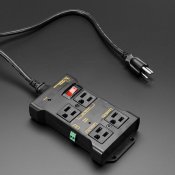- The probe has a sensor hole, and that hole will cast a shadow on part of the photodiode when measuring away from the center of the image. I suggest raising the photodiode to be almost flush with the top. Darkroom Automation did that.
When I was designing the meter probe, I believe I did some "back of the envelope" calculations on light angles to see if I'd have issues. I think I came out of that okay. I also recall this problem actually not being as bad as you'd think it would be. However, I should spend some time re-doing those calculations, and documenting the whole process, so I can experiment with different designs. One issue I have to contend with regardless, however, is that I can't elevate the sensor above the PCB without putting it on a daughterboard. That being said, making the enclosure as thin as possible above the sensor is another approach that I'm at least partially doing already.
For what its worth, I expect putting a transparent/translucent cover on top of the sensor hole will affect my readings. So I really need to start getting serious about that, to see what the data looks like.
Regardless, a huge point of my design was to make the meter probe "something I can muck with." Therefore, I fully expect to have to iterate on it once I start doing actual darkroom tests with real negatives.
- If you are blocked by required government approvals, consider removing the timer function, turning this device into a smart meter. Then it can be powered by a separate already-approved off-the-shelf module that supplies a low voltage to your device.
The thought has occurred to me, but I really still need to be able to actually control the enlarger and safelight to do what I want. If there was a 3rd party "off the shelf" box I could plug in to provide this function, I'd consider making a version that used it. Unfortunately, I haven't been able to find any good choices here.
- Consider labeling the buttons with words instead of symbols. That would allow the unit to be used without reading the manual. Symbols communicate little to a new user.
What's interesting with this is that RH uses symbols for the Analyser, but uses words for the StopClock. I'm not really set on the artwork yet, but my biggest hesitations with words is that they're harder to read (especially under darkroom conditions), make it harder to change functions, and you really can pick fairly obvious symbols for the most common features.
- Consider adding single-function buttons for common operations, such as "Select Paper", "Test Strip", "F-Stop Timing Mode", and "Clear Measurements". Alternatively, you can add soft-function buttons along the bottom of the display.
I'm actually doing this already. One of my biggest gripes about the RH product is needing to remember specific button combinations for certain features. I want to avoid that as much as possible. So yeah, I already have dedicated buttons for some of these. In places where I can't easily have a dedicated button, I can actually present the user with a clear text menu (something impossible on those circa-1996 units that only use 7-segment LCDs for their displays).
Another thing I included (though I'm not yet sure how effectively I'll be able to take advantage of this), is a few buttons that have embedded LEDs. The idea here is that I can have a visual indication of either what mode you're in, or what buttons you can push.
I should also mention that all of the LEDs on the panel of this device (both the ones embedded in buttons, and the ones surrounding the buttons for general illumination) are individually controllable. So while I currently don't have plans to leverage that too much, it may give me interesting options in the future. (Its great what you can do with modern special-purpose ICs. Why bother building some "simple" circuit to drive 10-14 LEDs with adjustable brightness when you can simply buy a 16-channel constant current LED driver chip with individual channel control for like $1 before quantity discount.)




